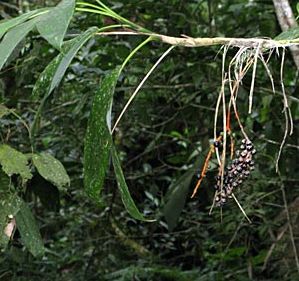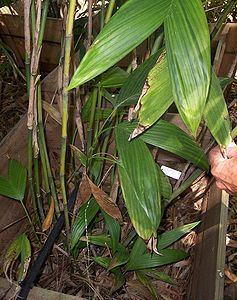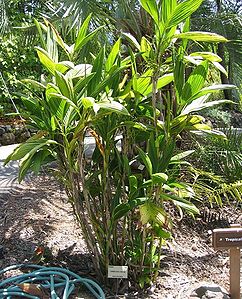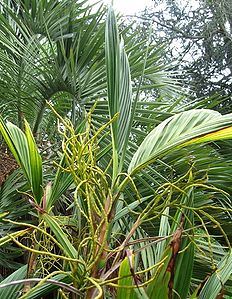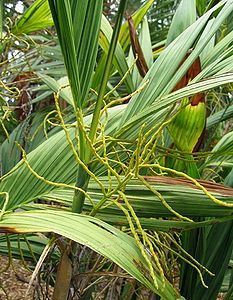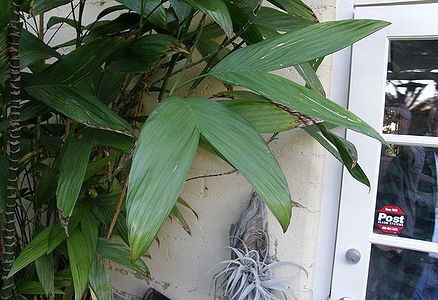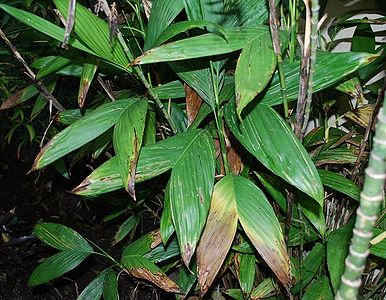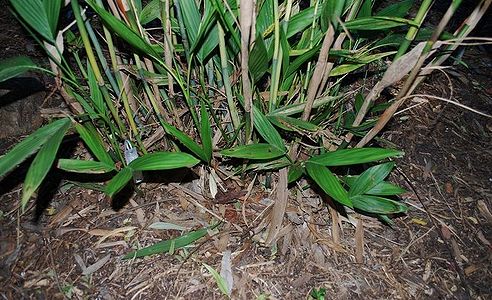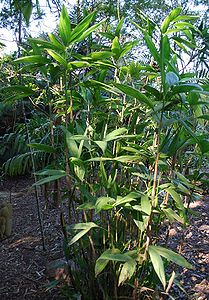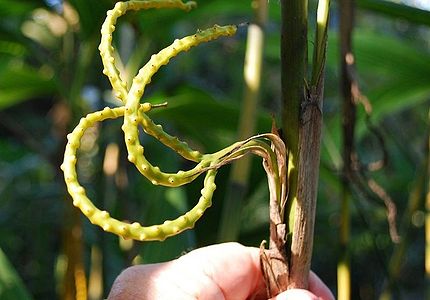Chamaedorea nubium
<google>CH02</google>
| Chamaedorea (kam-eh-DOR-eh-ah) nubium (NOO-bee-uhm) | |||||||
|---|---|---|---|---|---|---|---|
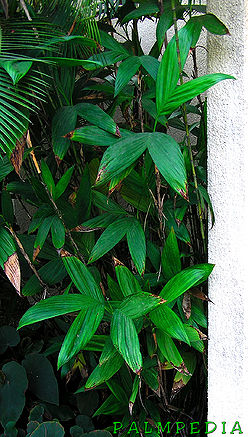 So. California. | |||||||
| Scientific Classification | |||||||
| |||||||
| Synonyms | |||||||
|
| |||||||
| Native Continent | |||||||
|
| |||||||
| Morphology | |||||||
| |||||||
| Culture | |||||||
|
| |||||||
| Survivability index | |||||||
|
| |||||||
| Common names | |||||||
|
| |||||||
Contents
Habitat and Distribution
El Salvador, Guatemala, Honduras, Mexico Southeast, Mexico Southwest. MEXICO. Chiapas. Guerrero. Oaxaca. GUATEMALA. Alta Verapaz. Baja Verapaz. El Progreso. Huehuetenango. San Marcos. Zacapa. EL SALVADOR. Chalatenango. Santa Ana. Moist or wet montane forest and cloud forest on the Atlantic and Pacific slopes; alt. 1,500-2,500 m (4900 and 8200 ft.) elevation.
Description
Habit: caespitose (growing in tufts or clumps), erect or decumbent, forming dense or loose and wide-ranging colonies 5-10 m across. Stems: hight to 4 m, 8-10 mm in diam., smooth, green, ringed, rooting and infrequently sprouting at nodes, uppermost internodes short, lower ones to 12 cm long, often covered by persistent leaf sheaths. Leaves: 4-7 per crown, spreading, bifid or rarely pinnate; sheath 20-30 cm long, tubular, obliquely open apically and there lighter green and longitudinally striate-nerved, old sheaths drying brown, persistent; petiole 8-13 cm long, flattened and very slightly grooved near base and green above, rounded and pale below; rachis 8-15 cm long, angled and green above, rounded with pale yellowish band below extending onto sheath; blades to 45 x 30-35 cm, incised apically to 2/3 their length, green or distinctly glaucous below, lobes narrowly long-acute, cuneate-acute basally, interior margins to 20-33 cm long, exterior margins entire or slightly toothed, 12-17 prominent primary nerves on each side of rachis, these keeled and green above, light green below, 2 secondaries between each pair of primaries, tertiaries numerous, faint; or rarely blades partially to completely pinnate, then with rachis 25-33 cm long with 6-13 pinnae on each side, to 31 x 2 cm, linear-Ianceolate, falcate, midrib and a primary nerve on each side of this, these keeled, apical pinnae slightly or much broader than others, to 7-nerved. Inflorescences: infrafoliar, sometimes emerging through persistent sheaths, erect-spreading; peduncles 10-27 cm long, 2-5 mm wide at apex and there rounded, 3-5 mm wide at base and there ± flattened, erect, pale green or yellowish in flower, nodding and red-orange in fruit; bracts 4-5, prophyll 1.5 cm long, 2nd bract 3 cm, 3rd 6.5 cm, 4th 9.5 cm, 5th 5.5 cm and often concealed by 4th, narrowly tubular, obliquely open apically, longitudinally striate-nerved, acute-acuminate, bifid, papery and drying brown in flower, uppermost equalling or slightly exceeding peduncle; rachises 1-4 cm long or more, greenish or yellowish in flower, red-orange in fruit. Staminate with up to 15 rachillae, these 6-15 cm long, 1-2 mm in diam., yellow, spreading and slightly drooping but not pendulous, frequently markedly undulate. Pistillate with up to 10 rachillae or infrequently spicate or forked, these 8-15 cm long, 3-3.5 mm in diam., erect, obtusely angled, and pale green in flower, swollen to 5 mm in diam., downward pointing, and red-orange in fruit, frequently strongly undulate when dry. Flowers: Staminate in loose or ± moderately dense spirals but appearing as though in opposite lines, 2-2.5 mm apart, 1.5-2 x 3-3.5 mm, depressed-globose, laterally compressed, golden yellow, sunken in narrowly elliptic depressions in curves of axis; calyx 0.5-0.75 x 2.5-3 mm, lobed, membranous, sepals connate in basal 1/2, broadly rounded to straight apically; petals 2 x 2 mm, valvate, broadty ovate, connate in basal 1/3, free but incurved apically, acute, tips only slightly recurved, ± thick; stamens 11.5 mm, filaments very short, anthers 0.7-0.75 mm, bifid apically, brownish; pistillode 1.5 x 0.75 mm, broadly columnar, whitish. Pistillate in loose or moderate spirals but appearing nearly distichous, 1.5-2 x 4 mm, shieldlike, pale yellow, sunken in depressions 2.5 mm long; calyx 1 x 4 mm, shallowly lobed, sepals imbricate in basal 3/4, broadly rounded or straight apically; petals 2.5 mm long, imbricate nearly to apex and corolla opening only slightly apically, thickened in fruit, broadly triangular, drying dark brown; staminodes present; pistil shieldlike, 1.5-2 mm high, yellowish, stigma lobes sessile, short, exserted, bluntly pointed, dark. Fruits: to 14 x 11 mm, ovoid-globose, black at maturity with a glaucous bloom. (Hodel, D.R. 1992) Editing by edric.
Standley and Steyermark (1947) described and named C. nubium from material collected in Guatemala. We have collected it in wet cloud forest on the Atlantic slope in Baja Verapaz, Guatemala and Chiapas, Mexico. We also collected it in oak-pine forest on the Pacific slope of Oaxaca, Mexico. C. nubium is an extremely handsome plant, forming large clumps several meters across of leaning, slender stems topped with large bifid leaves. In Guatemala, we found colonies 10-15 m across of loose and far-ranging stems, all of one sex. Here the plants had erect to decumbent stems that tended to root and sprout at the nodes and leaves distinctly white-glaucous below. Mexican plants had leaves that were green below. Relatively easy to grow, C. nubium is not too dissimilar in habit to C. brachypoda, only usually larger. The generally smaller size, rhizomatous habit, and green flowers easily distinguish C. brachypoda. C. nubium grows more vigorously in southern California and is much superior to C. brachypoda there; its leaves do not yellow-and brown-tip as do those of C. brachypoda. C. nubium is uncommon in cultivation, until recently appearing in only a few collections in southern California. Loran Whitelock of Los Angeles introduced these in 1981 from Oaxaca, Mexico. Recently, we have collected seeds in Guatemala and distributed them as Hodel & Castillo 899. Standley and Steyermark (1947, 1958) relied heavily on the undulate rachillae as a distinguishing character of C. nubium, a feature that I have found not to be a good diagnostic character. Rather the undulating nature is quite variable and seems to depend on the age of the rachillae when collected and dried. (Hodel, D.R. 1992)
Culture
Requirements: Full shade to filtered light, this is an understory palm. Consistently moist soil, well drained position. This palm can be propagated by air layering, because the stem nodes will produce roots if kept moist. Its large, entire, deeply bifid leaves that can get to 45 cm (18 in.) long make it a stunning ornamental. It is also one of the more cold tolerant Chamaedorea due to its high altitude habitat and will take prolonged cool temperatures and moderate freezes without harm. It does well in the understory of a cool to warm temperate garden, but is still very rare in cultivation. This palm can be propagated by layering, because the stem nodes will produce roots if kept moist.
Comments and Curiosities
Chamaedorea are dioecious, male, and female flowers, on separate plants.
Etymology: Is the Latin word meaning ofthe clouds, apparently in reference to the relatively high elevation, mountain cloud forest habitat, although the authors did not specify the application of the name.
External Links
References
Phonetic spelling of Latin names by edric.
Special thanks to Geoff Stein, (Palmbob) for his hundreds of photos, edric.
Special thanks to palmweb.org, Dr. John Dransfield, Dr. Bill Baker & team, for their volumes of information and photos, edric.
- IMAGE GALLERY
Many Special Thanks to Ed Vaile for his long hours of tireless editing and numerous contributions.



